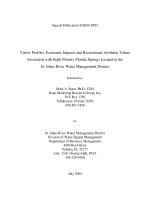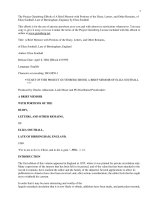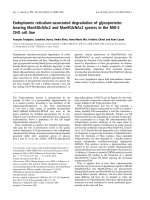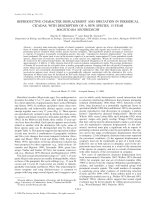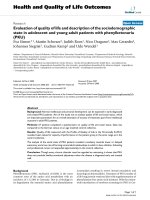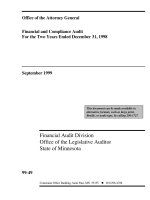Two genera and one species newly recorded with description of five new species of the subfamily Microgastrinae (Hymenoptera: Braconidae) from Vietnam
Bạn đang xem bản rút gọn của tài liệu. Xem và tải ngay bản đầy đủ của tài liệu tại đây (294.94 KB, 10 trang )
30(3): 78-87
T¹p chÝ Sinh häc
9-2008
TWO GENERA AND ONE SPECIES NEWLY RECORDED WITH DESCRIPTION
OF FIVE NEW SPECIES OF THE SUBFAMILY MICROGASTRINAE
(HYMENOPTERA: BRACONIDAE) FROM VIETNAM
KHUAT DANG LONG
Institute of Ecology & Biological Resources (IEBR), Ha Noi, Vietnam
C. VAN ACHTERBERG
Nationaal Natuurhistorisch Museum (RMNH) Leiden, The Netherlands
ABSTRACT: The genera Alloplitis Nixon, 1965 and Protapanteles Ashmead, 1898 (subgenus Nyereria
Mason, 1981) (Braconidae: Microgastrinae) are newly recorded for Vietnamese fauna.
Three valid species of the genus Alloplitis Nixon, 1965 and one species of the subgenus Nyereria Mason
[15] are currently recognized from the Oriental region, and in this paper one species is newly recorded for
the fauna of Vietnam, Alloplitis guapo Nixon, 1965 and five new species are described and illustrated
from Vietnam, Alloplitis albiventris Long & van Achterberg, sp. n., A. laevigaster Long & van
Achterberg, sp. n., A. vietnamicus Long & van Achterberg, sp. n., Protapanteles (Nyereria) albicentrus
Long & van Achterberg, sp. n. and P. (Nyereria) yenthuyensis Long & van Achterberg, sp. n.. In
collections these genera are rare, probably because Braconidae has been only limited collected by Malaise
traps in Vietnam.
For recognition of the subfamily Microgastrinae, see Nixon (1965) [10], for division of groups of the
genus Apanteles s. l. see Wilkinson (1932) and Nixon (1965, 1967), for reclassification of the subfamily
Microgastrinae see Nixon (1965) and Mason (1981). For the terminology used in this paper, see van
Achterberg (1993). The scale-lines of the plates indicate 1 mm.
Key words: Braconidae, Microgastrinae, Alloplitis, Nyereria, Protapanteles, new species, Vietnam.
TAXONOMY
Key to Vietnamese species of the genus Alloptilis Nixon
1. Tergite 3 rugose and much shorter than tergite 2 (about half as long as tergite 2), fore wing with
small second submarginal cell, hind coxa yellow…................A. guapo Nixon, 1965
- Tergite 3 smooth and longer than 2/3 of tergite 2, if distinctly shorter than half of tergite 2 then
tergite 2 smooth or hind coxa black or blackish brown, fore wing with large or medium-sized
second submarginal cell .......................................…..................................................................... 2
2. Tergite 3 less than half as long as tergite 2, tergites 2+3 smooth, inner hind tibial spur 0.5 times
as long as hind basitarsus .................................................................................A. laevigaster sp. n.
- Tergite 3 about as long as tergite 2, tergite 2 rugose, inner hind tibial spur shorter or as long as
than 1/3 of hind basitarsus ………………………………………………………………………..3
3. Fore wing with a large second submarginal cell, hind femur and tibia yellow, metasoma black or
blackish brown ...............................................................................................A. vietnamicus sp. n.
- Fore wing with a medium-sized second submarginal cell, hind femur and tibia black, metasoma
brown but ventrally white or whitish yellow ....................................................A. albiventris sp. n.
78
Alloplitis albiventris Long & van
Achterberg, sp. n. (figs 1-8)
Material. Holotype, ♀, (IEBR), Mic.570,
Vietnam: Hoabinh (Yenthuy), fruit orchard
(MT), 20˚23’47N 105˚36’14E, 01-10.IV.2002,
K. D. Long.
Holotype, ♀, body length 2.7 mm, fore wing
length 2.7 mm, antenna 3.0 mm.
Head (figs 1-2).- Antenna longer than body,
length of third segment as long as fourth
segment; conical apical segment as long as
penultimate segment; 12th-16th antennal
segments distinctly swollen (fig. 6). Head in
frontal view with antennal sockets far above
middle level of eyes (fig. 2); frons with
prominent long median carina and convergent
rugosities (V-shaped); width of face 0.7 times
height of eye and clypeus combined (15: 21);
height of eyes 2.4 times width (22: 9); tentorial
pits large, distance between tentorial pits 3.0
times distance from pit to eye margin (9: 3).
Head in dorsal view with ocelli small and in a
low triangle, the anterior tangent to posterior
ocelli cutting anterior ocellus (fig. 1); POL 1.5
times OOL and 2.0 times diameter of posterior
ocellus (OD) (6: 4: 3). Face dull, rugosepunctate with a long median smooth carina (fig.
2) shiny; vertex, occiput and temple close
rugose-punctate.
Figs 1-8. Alloplitis albiventris Long & van Achterberg, sp. n.
1. head, dorsal aspect; 2. head, frontal aspect; 3. mesonotum; 4. propodeum;
5. hind leg; 6. fore wing; 7. apical antennal segments.
Mesosoma.- Mesonotum as wide as head in
dorsal view (36: 32); mesoscutum close
reticulate-punctate with longitudinal rugosities
posteriorly;
scutellum
reticulate-punctate;
scutellar sulcus deep and wide with 5 carinae
and 0.3 times as long as scutellum (4: 12) (fig.
3); mesopleuron rugose-punctate anteriorly,
shiny and smooth posteriorly; mesosternum
rugose-punctate
anteriorly
and
rugose
posteriorly; precoxal sulcus wide, shallow with
reticulate punctures; propodeum with lateral
carinae, irregular costulae and areolate-rugose.
Wings.- Fore wing with radial vein r arising
just after middle of pterostigma; vein r twice
long as vein 2-SR (8: 4), and little longer than
width of pterostigma (8: 7) (fig. 6); metacarp
longer than length of pterostigma (21: 20); vein
1-CU1 0.6 times as long as vein 2-CU1 (6: 10),
2-CU1 1.25 times as long as vein m-cu.
Legs.- Hind tibia gradually swollen apically
(fig. 5) and about 1.1 times as long as hind
tarsus 1-5 (35: 33); inner hind tibial spurs about
0.5 times hind basitarsus (7: 15); fourth tarsal
segment shorter than fifth tarsal segment (3: 4)
(fig. 5).
Metasoma.- Length of horizontal surface of
tergite 1 about 0.6 times as long as its apical
width; third tergite 0.8 times as long as second
tergite (8: 10) (fig. 8); surface of tergite 1+2
areolate-rugose; second metasomal suture and
third tergite smooth.
79
Colour.- Body black; palpi white; scape
yellow, light brown ventrally with long setae;
flagellum yellow, darker apically; fore and
middle legs yellow, hind legs black except
trochanters and tarsus 2-5 yellow; hind tibial
spurs white.
Male: unknown.
Notes: Alloplitis albiventris sp. n. is close to
A. guapo Nixon, 1965, described from
Philippines, but it differs from the latter by the
following features: i)- tergite 3 smooth and
about as long as tergite 2 (0.9 times), ii)propodeum with lateral carinae, iii)- frons with
prominent carina and convergent rugosities (Vshaped) and iiii)- metasoma white or whitish
yellow ventrally.
Alloplitis laevigaster Long & van
Achterberg, sp. n. (figs 9-16)
Material. Holotype, ♂, (IEBR), Mic.201,
Vietnam: Hoabinh (Yenthuy), fruit orchard
(MT), 20˚23’47N 105˚36’14E, 20-30.VII.2002,
K. D. Long.
Holotype, ♂, body length 2.9 mm, fore wing
length 3.2 mm, antenna 4.2 mm.
Head (figs 9, 10).- Antenna longer than
body, length of third segment as long as fourth
segment; apical segment a little longer than
penultimate segment (fig. 16). Head in frontal
view with antennal sockets above middle level
of eyes (fig. 10); frons with a short median
carina; width of face 0.8 times height of eye and
clypeus combined (19: 23); height of eyes about
2.2 times width (24: 11); tentorial pits large,
distance between tentorial pits 3.3 times
distance from pit to eye margin (10: 3). Head in
dorsal view with temple roundly narrowed
posteriorly (fig. 9); ocelli small and in a very
low triangle, the anterior tangent to the posterior
ocelli cutting anterior ocellus; POL 2.0 times
OOL and 4.0 times diameter of posterior ocellus
(OD) (4: 2: 1). Face finely punctate; vertex,
occiput and temple rugose-punctate.
Mesosoma.- Mesonotum wider than head in
dorsal view (40: 38); mesoscutum reticulaterugose, notauli present, meeting posteriorly;
lateral lobes of scutum with more or less
discrete punctures apically; scutellar sulcus
narrow and deep, with 3 carina, about 0.3 times
as long as scutellum; scutellum rugose-punctate
(fig. 12); mesopleuron rugose anteriorly,
polished smooth posteriorly; precoxal sulcus
shallow, shiny and smooth; mesosternum
punctate throughout; propodeum dull with
areola and costulae (fig. 11).
Figs 9-16. Alloplitis laevigaster Long & van Achterberg, sp. n.
9. head, dorsal aspect; 10. head, frontal aspect; 11. propodeum; 12. mesonotum;
13. first-third tergites; 15. hind tibia and tarsus; 16. apical antennal segments
80
Wings.- Fore wing with radial vein r arising
at middle of pterostigma; vein r as long as vein
2-SR (8: 8), and shorter than width of
pterostigma (8: 9); metacarp about 1.1 times
length of pterostigma (26: 23); ratio of vein 1CU1: 2-CU1; m-cu = 6: 11: 7 (fig. 14). Hind
wing: cu-a curved apicad.
Legs.- Hind tibia gradually swollen apically
(fig. 15); hind femur shorter than hind tibia (32:
38); hind tibia as long as hind tarsus 1-5 and
more than 2.2 times as long as hind basitarsus;
inner hind tibial spurs much shorter than half of
hind basitarsus; fourth tarsal segment shorter
fifth tarsal segment (4: 5) (fig. 15).
Metasoma.- Horizontal suface of tergite 1 as
long as tergite 2 and about 0.6 times as long as
apical width of tergite 1; third tergite 0.8 times
as long as tergite 2 (8: 10); tergite 1 finely
rugose, tergites 2+3 polished smooth; second
metasomal suture weak (fig. 13).
Colour.- Body black; palpi white; scape and
pedicel yellow; flagellum brown, yellowish
brown apically; fore and middle legs yellow;
hind coxa, femur and tibia dark brown, except
hind tibia whitish yellow basally; hind tarsus
4+5 yellow; fore wing with dense and long
setae.
Female: unknown.
Notes: Alloplitis laevigaster sp.n. is close to
A. completus Mason, 1981, from Malaysia but it
differs from the latter by the following features:
i)- metasoma black ventrally, ii)- tergite 2
smooth and iii)- tergite 3 shorter than 0.5 times
tergite 2. This species is also close to A. typhon
Nixon, 1965, from the Philippines but differs
from the later by: i)- tergite 3 shorter than 0.5
times tergite 2, ii)- hind femur blackish brown
to black.
Alloplitis vietnamicus Long & van
Achterberg, sp. n. (figs 17-24)
Material.- Holotype, ♀,(IEBR) “Mic.939,
Vietnam: Vinhphuc (Melinh), secondary forest
(MT), 21˚23’N 105˚42E, 20-30.III.2001, K. D.
Long”. Paratypes, ♀,(IEBR) Mic.939a, same
data as holotype; ♀, (RMNH), Mic.953, VN:
Hagiang (Vi Xuyen), forest 700 m, K. D. Long.
Holotype, ♀, body length 2.2 mm, fore wing
length 2.5 mm, antenna 2.4 mm.
Figs 17-24. Alloplitis vietnamicus Long & van Achterberg, sp. n.
17. antennae; 18. head, dorsal aspect; 19. head, frontal aspect; 20. scutellar sulcus and scutellum;
21. fore wing; 22. first-third tergites; 23. propodeum; 24. apical metasomal segments, lateral aspect.
Head (figs 18, 19).- Antennae little longer
than body, penultimate segment wider than
long; head in frontal view with antennal sockets
above middle level of eyes (fig. 18); width of
face 0.7 times height of eye and clypeus
combined (15: 21); height of eyes 2.25 times
width (18: 8); tentorial pits large and closed to
mandible base, distance between tentorial pits
81
4.0 times distance from pit to eye margin (8: 2).
Head in dorsal view with temple roundly
narrowed posteriorly (fig. 19); ocelli in a low
triangle with posterior ocellus larger, the
anterior tangent to the posterior ocelli cutting
anterior ocellus; POL 1.25 times OOL and
about 1.7 times diameter of posterior ocellus
(OD) (5: 4: 3) (fig. 19); frons with a short
longitudinal carina (fig. 18); face rugose; vertex,
occiput and temple rugose.
Mesoma.- Mesonotum wider than head in
dorsal view (35: 31); scutellar sulcus deep with
median carina (fig. 20), about 0.4 times as long
as scutellum (4: 11); mesoscutum reticulaterugose becoming striate-rugose apically;
scutellum irregularly rugose; large area of
mesopleuron rugose, smooth smaller area in
middle; precoxal sulcus deep and rugose;
mesosternum rugose; propodeum with areola
and costulae, sparsely rugose (fig. 23).
Wings.- Fore wing with radial vein r arising
after middle of pterostigma; vein r 1.2 times as
long as vein 2-SR (6: 5), and equal pterostigma;
metacarp shorter than length of pterostigma (15:
20); ratio of vein 1-CU1: 2-CU1: m-cu = 5: 10:
6 (fig. 21).
Legs.- Hind tibia gradually swollen apically;
hind femur about 0.8 times hind tibia (25: 32)
and shorter hind tarsus 1-5 (32: 33); hind
basitarsus 0.45 times as long as hind tarsus 1-5;
inner hind tibial spurs 0.4 times as long as hind
basitarsus (6: 15); fourth tarsal segment shorter
fifth tarsal segment (4: 5).
Metasoma.- Horizontal surface of first
tergite about 0.5 times as long as apical width,
third tergite 0.9 times tergite 2 (9: 10) (fig. 22);
tergite 1 areolate-punctate, striate laterally;
tergite 2 finely punctate and striate basally;
tergite 3 finely striate; ovipositor sheath
projecting behind (fig. 24).
Colour.- Body black; palpi white; scape and
pedicel yellow; flagellum yellow, darker
apically; fore and middle legs yellow; hind legs
yellow except hind coxa yellowish brown, hind
tibia and basitarsus pale brown apically.
Male: unknown.
Notes: Alloplitis vietnamicus sp. n. is close
to A. guapo Nixon, 1965, from Philippines but it
differs from the latter by the following features:
i)- tergite 3 smooth and longer than haft of
tergite 2, ii)- penultimate antennal segment
shorter than wide, iii)- inner hind spur 0.3 times
as long as hind basitarsus and iiii)- propodeum
without medial longitudinal carina.
Alloplitis guapo Nixon, 1965
This species has been found in Cucphuong
national park, North Vietnam (IEBR: Ninhbinh
province), MT, 20˚23’06N 105˚34’11E, 2030.VI.2002, K. D. Long.
Key to Vietnamese species of the genus Protapanteles Ashmead, 1898
(subgenus Nyereria Mason, 1981)
1. Ocelli in a very low triangle, anterior tangent to posterior ocelli cutting center of anterior ocellus;
scutellar sulcus with 7 distinct carinae; scutellum and metanotum in dorsal view with an dorsal
spine (fig. 38); a raised central area of tergite 2 with longitudinal striae, lateral area of tergite 2
and basal area of tergite 3 with sparse sharp pits; tergite 1 and hind coxa whitish yellow (but hind
coxa of male reddish yellow)......................................Protapanteles (Nyereria) albicentrus sp. n.
- Ocelli higher, anterior tangent to posterior ocelli just touching anterior ocellus; scutellar sulcus
without carinae; scutellum and metanotum in dorsal view without a strong apical spine; a raised
central area of tergite and 2 tergite 3 polished smooth; tergite 1 black; and hind coxa black, pale
brown apically..........................................................Protapanteles (Nyereria) yenthuyensis sp. n.
Protapanteles (Nyereria) albicentrus
Long & van Achterberg, sp. n. (figs 25-32)
Material. Holotype, ♀, (IEBR), Apan.740,
Vietnam: Hatinh (Huongson), forest, (MT),
20˚59’N 105˚55’E, 22.VI-08.VII.2001, AMNH,
82
K. Long. Paratypes ♂,(IEBR), Mic.1044, same
locality but forest 900m, MT 05.V.1998, AMNH,
K. Long; ♀, (RMNH) Mic.1023: Vietnam:
Hatinh (Huongson), forest, (MT), 18˚22’N
106˚13’E, 20-28.IV.1998, AMNH, K. Long.
Holotype, ♀, body length 3.4 mm, fore wing
length 3.6 mm, antenna 3.7 mm.
Head.- Antenna longer than body; length of
third segment a little longer fourth (12: 11);
apical segment equal to penultimate segment.
Head in frontal view with antennal sockets just
above middle level of eyes (fig. 26); width of
face equal to height of eye and clypeus
combined; height of eyes 0.9 times width (17:
18); tentorial pits small, distance between
tentorial pits 1.4 times distance from pit to eye
margin (7: 5); head in dorsal view with temple
roundly narrowed posteriorly (fig. 25); ocelli in
a very low triangle, the anterior tangent to
posterior ocelli cutting anterior ocellus (fig. 25);
POL 1.5 times OOL (6: 4) and 2.0 times OD (6:
3) (fig. 25); face punctate; vertex, occiput and
temple rugose-punctate.
Metasoma.- Tergite 1 parallel-sided (fig.
30), length of first tergite 1.25 times apical
width (15: 12); horizontal surface of first tergite
shorter than apical width (9: 12); tergite 2
shorter than tergite 3 (10: 12); ovipositor sheath
short and down curved apically (fig. 28).
Colour.- Head and thorax black; palpi white;
scape and pedicel yellow; basal third of
flagellum yellowish brown, apical two thirds of
flagellum brown; fore and middle legs yellow;
hind legs yellow, except apical half of hind tibia
and complete hind tarsus blackish brown; wing
veins yellow, pterostigma and metacarp brown;
tergite 1 and sternites 1-4 white or whitish
yellow; tergites 2+3 blackish brown, tergites 4-7
yellowish brown.
Male: unknown.
Figs. 25-32. Protapanteles (Nyereria) albicentrus Long & van Achterberg, sp. n.
25. head, dorsal aspect; 26. head, frontal aspect; 27. mesonotum; 28. apical metasomal segments, lateral
aspect; 29. hind tarsus; 30. first-third tergites; 31. scutellum and metanotum, lateral aspect; 32. fore wing.
Protapanteles (Nyereria) yenthuyensis
Long & van Achterberg, sp. n. (figs 33-39)
Material. Holotype, ♀, (IEBR), Mic.918,
Vietnam: Hoabinh (Yenthuy), (MT), forest,
20˚28’N 105˚34’E, 20-30.X.2003, K. D. Long.
Holotype, ♀, body length 2.3 mm, fore wing
length 2.6 mm, antenna 2.5 mm.
Head (figs 33, 34)- Antenna distinctly
longer than body, length of third segment
slightly longer fourth (8: 7); apical segment
equal penultimate segment; width of face
shorter than height of face and clypeus
combined (13: 15); height of eyes 2.0 times
width (14: 7); tentorial pits small, distance
between tentorial pits 2.7 times distance from
pit to eye margin (8: 3) (fig. 34); head in dorsal
83
view with temple roundly narrowed posteriorly
(fig. 33); ocelli small in a low triangle, the
anterior tangent to the posterior ocelli touching
anterior ocellus; POL equal times OOL and 2.0
times diameter of posterior ocellus (4: 2) (fig.
33); fons prominent with median longitudinal
carina; face densely punctate; stemmaticum
shiny, smooth; vertex, occiput and temple finely
punctate.
Mesosoma.- Mesonotum as wide as head in
dorsal view; mesoscutum with discrete
punctures, punctures fading posteriorly; basal
haft of scutellum with sharp discrete punctures
becoming coriaceous posteriorly; scutellar
sulcus dull and rugose (fig. 35); mesopleuron
largely smooth, finely punctate anteriorly;
propodeum with a short basal longitudinal
carina, apical haft of propodeum rugose.
Wings.- Fore wing with radial vein r arising
after middle of pterostigma; vein r and vein 2SR curved not angled (fig. 39); metacarp 1.4
times length of pterostigma (28: 20); vein 1-
CU1, vein 2-CU1 and m-cu equal.
Legs.- Hind coxa shiny smooth, ratio of hind
femur: tibia: tarsi 1-5 and basitarsus = 31: 34: 40:
16; inner hind tibial spurs about 0.6 times hind
basitarsus (9: 16); fourth tarsal segment as long
as fifth tarsal segment; inner side of hind
basitarsus with strong setae (fig. 38).
Metasoma.- Horizontal surface of tergite 1
rugose, about 0.7 times as long as apical width
(6: 9), slightly and roundly wider apically;
median section of tergite 2 coriaceous, as long
as horizontal surface of tergite 1 and shorter
than tergite 3 (6: 7) (fig. 37); tergite 3 shiny and
smooth.
Colour.- Body black; palpi white; scape
yellow; flagellum yellowish brown basally; fore
and middle legs yellow; hind coxa brown,
yellow apically; trochanters and hind femur
yellow; basal one third of hind tibia yellow,
apical two third and hind tarsus brown; wing
vein yellow; pterostigma and metacarp brown.
Male: unknown.
Figs 33-39. Protapanteles (Nyereria) yenthuyensis Long & van Achterberg, sp. n.
25. head, dorsal aspect; 26. head, frontal aspect; 27. mesonotum; 28. apical metasomal segments, lateral
aspect; 29. hind tarsus; 30. first-third tergites; 31. scutellum and metanotum, lateral aspect; 32. fore wing.
REFERENCES
1. Achterberg C. van, 1993: Zoologische
Verhandelingen Leiden, 283: 1-189.
2. Austin A. D. & Dangerfield P. C., 1992:
Invertebrate Taxonomy, 6(1): 1-76.
3. Chen X. X., He J. H. & Ma Y., 1994:
84
Entomotaxonomia (in Chinese with English
summary), 16(2): 127-134.
4. Khuat Dang Long & Belokobylskij S. A.,
2003: Russian Entomological Journal,
12(4): 385-398.
5. Khuat Dang Long & van Achterberg C.,
2003: Zoologische Mededelingen Leiden,
77(10): 221-227.
6. Khuat Dang Long, 2007: Journal of
Biology, 29(2): 35-43.
7. Khuat Dang Long, 2007: Journal of
Biology, 29(3): 25-31.
8. Khuat Dang Long, 2007: Proceedings of
the 2nd National Scientific Conference on
Ecology and Biological Resources, 10: 140152.
9. Mason W. R. M., 1981: Memoirs of the
Entomological Society of Canada. no. 115.
10. Nixon G. E. J., 1965: Bulletin of the British
Museum (Natural History), Entomology
series. Supplement, 2: 1-284.
11. Nixon G. E. J., 1967: Bulletin of the British
Museum (Natural History), Entomology
series, 21(1): 1-34.
12. Sathe T. V. & Inamdar S. A.,1988: Journal
of Advanced Zoology, 9(2): 128-131.
13. Sathe T.V. & Inamdar S. A., 1991:
Hexapoda (Insecta Indica), 3(1-2): 89-93.
14. Wilkinson D. S., 1932: Trans. R. ent. Soc.
London, 80: 301-334.
15. Yu D. S., Achterberg K. van &
Horstmann K., 2005: Ichneumonoidea
2004
(Biological
and
taxonomical
information),
Taxapad
Interactive
Catalogue, Vancouver.
GHI NHậN MớI 2 GIốNG Và 1 LOàI CHO KHU Hệ, MÔ Tả 5 LOàI MớI
CHO KHOA HọC THUộC PHÂN Họ ONG Ký SINH MICROGASTRINAE
(HYMENOPTERA: BRACONIDAE) ở VIệT NAM
KHUấT ĐĂNG LONG, C. VAN ACHTERBERG
TóM TắT
Phân họ ong ký sinh Microgastrinae là một trong những phân họ lớn với rất nhiều loài. Đến nay, ở Việt
Nam chúng tôi mới thống kê đợc các loài thuộc 5 giống Apanteles Foerster, 1862; Cotesia Cameron, 1891;
Fornicia Brullé, 1846; Microplitis Foerster, 1862; Wilkinsonellus Mason, 1981 [4, 5, 6, 7, 8]. Trong bài này,
chúng tôi đa ra ghi nhận mới cho khu hệ của Việt Nam 2 giống: Alloptilis Nixon, 1965 và Protapanteles
Ashmead, 1898 (phân giống Nyereria Mason, 1981), 1 loài đợc ghi nhận mới cho khu hệ là Alloplitis guapo
Nixon, 1965. Năm loài mới cho khoa học thuộc hai giống này đợc mô tả và minh họa, đó là Alloplitis
albiventris Long & van Achterberg, sp. n.; A. laevigaster Long & van Achterberg, sp. n.; A. vietnamicus Long
& van Achterberg, sp. n.; Protapanteles (Nyereria) albicentrus Long & van Achterberg, sp. n. và
P. (Nyereria) yenthuyensis Long & van Achterberg, sp. n..
Giống Alloptilis Nixon, 1965
Alloplitis Nixon, 1965. Bull. Br. Mus. (Natural History), Ent. Ser. Suppl., 2: 268.
Type-species: Alloplitis guapo Nixon, 1965.
Đặc điểm chẩn loại: thuộc tộc Microplitini. Nhìn bên sờn gờ trớc của metanotum cách xa gờ sau của
scutellum, phía đỉnh scutellum có vết lõm đợc viền bởi gờ nổi. Mesoscutum thờng có rãnh lng khá rõ ở
nửa đỉnh và có gờ viền ở trên mấu ôm gốc cánh. Sờn bên pronotum có vết lõm rộng có nhiều khía nhăn. Đốt
trung gian ít nhiều có khoang lõm với gờ viền rõ (hình 4, 11, 23), không có gờ dọc giữa. ống chân sau phình
rộng ở đỉnh với ít lông cứng ngắn ở mặt ngoài (hình 5, 15), móng chân sau có một số răng nh hình lợc, cựa
ống chân sau ngắn. Cánh trớc có ô cánh marginal rộng thờng có 4 cạnh, đôi khi 3 cạnh (hình 7, 14, 21).
Cánh sau có gân cu-a lợn cong, rìa thùy cánh sau gần nh thẳng và nhẵn. Tấm lng bụng 1 ngắn hơi rộng ở
đỉnh, tấm lng bụng 2 và 3 là hai phần tơng phản nhau, tấm lng bụng 2 gần nh hẹp về phía đỉnh, dài hơn
tấm lng bụng 3 và nhăn đều, tấm lng bụng 3 nhẵn hoặc có khía dọc ở phần gốc (hình 8, 13, 22). Mấu ôm
bao máng đẻ trứng ngắn và nhẵn, bao máng đẻ trứng có lông măng ở sát phía đỉnh (hình 24).
Giống này hiện mới biết 3 loài đều thuộc khu hệ Đông Phơng [15]. Dới đây là khóa định loại cho bốn
loài từ khu hệ họ ong ký sinh Braconidae của Việt Nam, trong số đó 1 loài là ghi nhận mới và 3 loài đợc mô
tả là loài mới cho khoa học .
85
Khóa định loại 4 loài thuộc giống Alloptilis Nixon, 1965 ở Việt Nam
1. Tấm lng bụng 3 nhăn và dài bằng 0,5 lần tấm lng bụng 2, cánh trớc có ô cánh submarginal nhỏ, đốt
háng sau màu vàng............................................................................................Alloplitis guapo Nixon, 1965
- Tấm lng bụng 3 nhẵn, dài hơn 2/3 tấm lng bụng 2 (hình 8, 22), nếu ngắn hơn 0,5 lần tấm lng bụng 2 khi
đó tấm lng bụng 2 nhẵn (hình 13) hoặc đốt háng sau đen hoặc nâu đen, cánh trớc có ô cánh submarginal
trung bình hoặc rộng (hình 7, 14, 21), đốt háng sau nâu đen hoặc đen..........................................................2
2. Tấm lng bụng 3 ngắn hơn 1/2 tấm lng bụng 2, tấm lng bụng 2 nhẵn (hình 13), cựa ống chân sau dài gần
bằng 1/2 đốt bàn 1 chân sau (hình 15)..................................................................Alloplitis laevigaster sp. n.
- Tấm lng bụng 3 dài gần bằng 2/3 tấm lng bụng 1, tấm lng bụng 2 nhăn (hình 8, 22), cựa ống chân sau dài
gần bằng hoặc ngắn hơn 1/3 đốt bàn 1 chân sau (hình 5).........................................................................3
3. Cánh trớc có ô cánh submarginal rộng (hình 21), đùi và ống chân sau màu vàng, bụng màu đen hoặc nâu
đen.......................................................................................................................Alloplitis vietnamicus sp. n.
- Cánh trớc có ô cánh submarginal trung bình (hình 7), đùi và ống chân sau màu đen, bụng màu nâu hai bên
sờn bụng màu trắng ......................................... Alloplitis albiventris sp. n.
Alloplitis guapo Nixon, 1965 phân bố ở Philipin, ở Việt Nam loài này đợc tìm thấy ở VQG Cúc Phơng,
bẫy treo, 20O2306N - 105O3411E, 20-30.VI.2002, K. Đ. Long.
Alloplitis albiventris Long & van Achterberg, sp. n. (hình 1-8)
Mẫu vật. Holotype, , Mic.570: VN, Hòa Bình (Yên Thủy), vờn quả (bẫy treo), 20O2347N
105 3614E, 01-10.IV.2002, K. Đ. Long.
O
Chiều dài: thân 2,7 mm; cánh trớc 2,7 mm; râu đầu 3,0 mm. Vật chủ: cha rõ.
Con đực: cha rõ.
Nhận xét: Alloplitis albiventris sp. n. gần với loài A. guapo Nixon, 1965 của Philipin, nhng loài này có
đặc điểm khác ở chỗ: i)- tấm lng bụng 3 nhẵn và dài gần bằng 0,9 lần tấm lng bụng 2, ii)- đốt trung gian có
gờ nổi dọc gần hai bên sờn, iii)- giữa trán có gờ nổi và những nếp nhăn hình chữ V và iiii)- các tấm bụng
1+2+3 có màu trắng.
Alloplitis laevigaster Long & van Achterberg, sp. n. (hình 9-16)
Mẫu vật. Holotype, , Mic.201, (IEBR), VN: Hòa Bình (Yên Thủy), vờn quả (bẫy treo), 20O2347N
105 3614E, 20-30.VII.2002, K. Đ. Long.
O
Chiều dài: thân 2,9 mm; cánh trớc 3,2 mm; râu đầu 4,2 mm. Vật chủ: cha rõ.
Con cái: cha rõ.
Nhận xét: loài Alloplitis laevigaster sp. n. gần với loài A. completus Mason, 1981 của Malaysia nhng có
đặc điểm khác ở chỗ: i)- tấm bụng 1+2+3 đen, ii) - tấm lng bụng 2 nhẵn và iii) - tấm lng bụng 3 ngắn hơn
0,5 lần tấm lng bụng 2. Loài này rất gần với loài A. typhon Nixon, 1965 của Philipin nhng có đặc điểm khác
ở chỗ: i)- tấm lng bụng 3 ngắn hơn 0,5 lần tấm lng bụng 2, ii)- ống chân sau màu nâu đen đến đen.
Alloplitis vietnamicus Long & van Achterberg, sp. n. (hình 17-24)
Mẫu vật. Holotype, , Mic. 939, (IEBR), VN: Vĩnh Phúc (Mê Linh), rừng thứ sinh (bẫy treo), 21O23N
105 42E, 20-30.III.2001, K. Đ. Long; paratype, , 939a, (IEBR), địa điểm nh holotype, paratype, ,
(RMNH), VN: Hà Giang (Vị Xuyên), vờn rừng 700m, (bẫy treo) 01-25.XI.2001, K. Đ. Long.
O
Chiều dài: thân 2,2 mm; cánh trớc 2,5 mm; râu đầu 2,4mm. Vật chủ: cha rõ.
Con đực: cha rõ.
Nhận xét: loài Alloplitis vietnamicus sp.n. gần với loài A. guapo Nixon, 1965 của Philipin nhng có đặc
điểm khác ở chỗ: i)- tấm lng bụng 3 nhẵn và dài hơn 1/2 tấm lng bụng 2, ii)- chiều dài đốt râu sát đốt đỉnh
ngắn hơn chiều rộng, iii)- cựa trong ống chân sau dài bằng 1/3 đốt bàn 1 chân sau và iiii)- đốt trung gian
không có gờ nổi dọc giữa (có nhiều gờ nổi).
86
Giống Protapanteles Ashmead,1898
Protapanteles Ashmead,1898. Proc. Ent. Soc. Washington. 4: 155-171
Type-species (des.): Protapanteles ephyrae Ashmead, 1897 (= Apanteles paleacritae Riley)
Đặc điểm chẩn loại: giống Protapanteles (phân giống Nyereria Mason, 1981) [9] thuộc tộc Cotesiini.
Máng đẻ trứng gần nh bị mấu ôm (hypopygium) che kín, gần đỉnh của bao máng đẻ trứng có ít lông măng
(28, 36). Tấm lng bụng 1 bằng 1-2 lần chỗ rộng nhất (ở phân giống Nyereria) tấm lng bụng 1 dài bằng 2
lần chỗ rộng nhất hoặc có cạnh gần nh song song nhng đều lợn tròn rõ ở đỉnh, tấm lng bụng 2 có hai rãnh
lõm chụm về phía đỉnh, hai rãnh lõm này tạo thành quầng gần nh hình tam giác nguợc (hình 30, 37), tấm
lng bụng 2 bằng 2/3 chiều dài tấm lng bụng 3, quầng giữa rãnh lõm ở tấm lng bụng 1 và 2 nhăn, tấm lng
bụng 3 thờng nhẵn. Đốt trung gian nhẵn hoặc nhăn mờ nhng bóng, không có vết khoang lõm và không có
gờ dọc giữa. Sờn bên pronotum tơng tự nh ở giống Cotesia Cameron. Cánh trớc không có ô cánh
submarginal, gân r và gân 2-SR dài và ít nhiều tạo góc gãy rõ. Thùy hậu cánh sau lồi có phủ lông măng. Đốt
bàn 5 chân trớc ở con cái thờng có một lông măng cứng dài và uốn cong. Các loài thuộc giống này thờng
gặp ký sinh ở nhóm côn trùng thuộc họ Geometridae [9].
Giống này đã biết tới 212 loài thuộc khu hệ thế giới, phân giống Nyereria mới biết 19 loài, trong số đó 17
loài thuộc khu hệ của châu Phi, 1 loài thuộc khu hệ Đông Cổ Bắc còn khu hệ Đông Phơng có 1 loài
Protapanteles (Nyereria) ragheshri (Sathe, 1988) [12, 15]. Dới đây là khóa định loại 2 loài mới cho khoa
học từ khu hệ họ ong ký sinh Braconidae của Việt Nam.
Khóa định loại 2 loài thuộc giống Protapanteles Ashmead, 1898
(phân giống Nyereria Mason, 1981) ở Việt Nam
1. Ba mắt đơn rất thấp, tiếp tuyến rìa trớc hai mắt đơn sau cắt hẳn vào giữa mắt đơn trớc (hình 25); rãnh
lõm trớc scutellum có 7 gờ dọc rõ; scutellum có chấm lỗ tròn lớn và rời rạc giống nh chấm lỗ ở giữa
mesoscutum (hình 27); quầng giữa tấm lng bụng 2 có khía dọc, phần còn lại hai bên tấm lng bụng 2 và gốc
tấm lng bụng 3 có chấm lỗ nhỏ và tha (hình 30); tấm lng bụng 1 và háng sau màu vàng trắng (ở con đực,
háng sau màu nâu đỏ)....................................................................... Protapanteles (Nyereria) albicentrus sp. n.
- Ba mắt đơn cao hơn, tiếp tuyến rìa trớc hai mắt đơn sau chỉ cắt rìa dới mắt đơn trớc (hình 33); rãnh
lõm trớc scutellum hẹp và nhăn; scutellum có chấm lỗ nhăn khác với chấm lỗ mờ và tha ở giữa mesoscutum
(hình 35); quầng giữa tấm lng bụng 2 và tấm lng bụng 3 nhẵn bóng (hình 37); tấm lng bụng 1 và háng sau
màu nâu đen hoặc đen.................................................................... Protapanteles (Nyereria) yenthuyensis sp. n.
Protapanteles (Nyereria) albicentrus Long & van Achterberg, sp. n. (hình 25-32)
Mẫu vật. Holotype, , (IEBR), Apan.740, VN: Hà Tĩnh (Hơng Sơn), rừng, (bẫy treo), 20O59N
105O55E, 22.VI- 08.VII.2001, AMNH, K. Long. Paratype , (IEBR), Mic. 1044, địa điểm nh holotype,
rừng 900m, (bẫy treo), 05.V.1998, AMNH, K. Long; paratype, , (RMNH) Mic.1023, VN: Hà Tĩnh (Hơng
Sơn), rừng 900m, (bẫy treo), 18o22N - 106o13E, 20-28.IV.1998, AMNH, K. Long.
Chiều dài: thân 3,4 mm; cánh trớc 3,6 mm; râu đầu 3,7 mm.Vật chủ: cha rõ.
Protapanteles (Nyereria) yenthuyensis Long & van Achterberg, sp. n. (hình 33-39)
Mẫu vật. Holotype, , (IEBR), Mic.918: VN, Hòa Bình (Yên Thủy), (bẫy treo), rừng, 20O28N 105O34E,
20-30.X.2003, K. Đ. Long.
Chiều dài: thân 2.3 mm; cánh trớc 2,6 mm; râu đầu 2,5 mm.Vật chủ: cha rõ.
Con đực: cha rõ.
Ngày nhận bài: 15-2-2008
87
